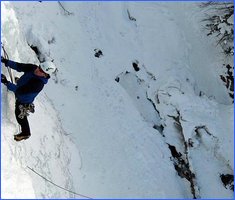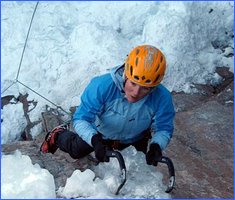NMS Ouray Ice Climbing
For a portion of each winter we travel to the historic Victorian mining town of Ouray, CO in the San Juan Mountains to hone our ice climbing skills. Ouray offers predictably fantastic ice climbs. The combination of reasonably priced lodging, good restaurants, nearby airports, and good local skiing, provide the perfect setting for practicing one of mountaineering's most important skills, ice climbing. An activity that at first glace appears strenuous and possibly crazy, proves to be easier to pick up than rock climbing. Most new climbers are able to climb WI 3 their first day and quickly progress to WI 4 and WI 5 during the week.
Ouray has two things that are rare in ice climbing: a very short approach, and dozens of routes within close proximity of each other. The Ouray Ice Park is a 2-mile long section of the Uncompagre Gorge, which has been set up with manufactured ice climbs. In the winter a full-time staff maintains an elaborate series of pipes, nozzles, and hoses, and produces hundreds of high quality ice routes with solid anchors at the top of each route. The park provides an ideal spot for new climbers to learn basic ice climbing technique and for experienced climbers to push their climbing skill to new levels. On days when the park is busy and the avalanche conditions in the surrounding mountains are acceptable, we have the option to venture onto alpine ice routes that range from one to several pitches.
Ice climbing can be enjoyed as an activity on its own or can provide good training for summer climbs in the Cascades or European Alps. Efficiently climbing ice is an essential skill for climbs of Denali, Cho Oyu, and other expedition peaks where the Northwest Mountain School operates. In each course we cover basics such as equipment selection, placing and removing ice screws, footwork, low angle, vertical and even over-hanging ice climbing technique and movement skills. Additionally we teach mixed climbing techniques on routes that involve climbing both rock and ice. Other topics include: building ice anchors, equalizing anchors, rappelling and belaying, belaying the second from above, and belay station management.
This program is appropriate for beginning climbers, and can be accelerated to accommodate those who already have ice-climbing experience. Petzl has hooked us up with the most modern ice climbing tools, crampons, helmets and harnesses for our customer's use and local shops rent a variety of ice climbing boots.
For the full adventure consider combining your ice climbing adventure with a day of skiing at nearby Telluride, or drive a few hours to sample the amazing climbing to be had in the desert of Southeastern UT.
The Northwest Mountain School guides under a permit held by the Certified Guides Cooperative an organization licensed to guide in the Ouray Ice Park. John & Olivia Race are CGC members.
Getting to/from Ouray, CO
If flying to CO, the air port closest to Ouray is Montrose, CO (MTJ), which is a 45 minute drive with shuttles available. Telluride (TEX) is the next closest at about 1 hour, and also has shuttles available. Grand Junction, CO (GJT) is a 2 hour drive and there currently does not appear to be a shuttle option an most people flying into Grand Junction will need to rent a car to get to Ouray. As weather is often an issue with flights in and out of Telluride, we suggest flying into either Montrose or Grand Junction if your schedule is not flexible. If driving to Ouray, expect about 6 hours from Denver to Ouray in good driving conditions.Accommodations, Food, and Daily Schedule
Ice climbing seminar participants generally arrive the day before their course starts and stay at one of the hotels that cater to ice climbers in the winter. Most hotels provide a simple breakfast as part of the room.
If space is available, we recommend staying at the Ouray Victorian Inn (www.ouraylodging.com or 800-846-8729), meeting point for each days ice climbing activities. Breakfast is included as part of the room rate. More lodging options can be found at www.ouraycolorado.com.
We meet each morning at 8 am at the "Vic" and then either walk to the nearby Ouray Ice Park, or carpool to one of the many routes in the surrounding mountains. On most days we stay out until late afternoon and on particularly cold days participants have the option of returning to town for a hot lunch.
Ouray has a variety of local restaurants for evening meals and the various groups of climbers will usually get together for dinner each night.
Equipment
Be sure to study our equipment list. In most cases the same clothing that works for skiing and climbing is suitable for ice climbing. We can provide you with a harness and helmet, and we have the latest ice tools, and crampons available for rental. The town of Ouray has a variety of shops where you can rent boots, but you will want to call ahead to make sure to reserve your size. Your guide will provide ropes, ice screws, and all other climbing gear.Qualifications
You do not need any previous ice climbing experience for our Ouray ice climbing seminars. Participants will need to arrive in good physical condition and be prepared to spend the day outside in an obviously cold environment. A variety of ice routes provide a logical starting point for climbers of all ability levels. Most routes in the park are top roped, and those routes outside the park are led by your guide and often cleaned by the second while climbing on top rope.Water Ice and Alpine Ice Grades
Ice climbing ratings still seems to vary a bit from one geographic area to another. These ratings attempt to average the ratings from different area and seem appropriate to ice in Colorado. The WI acronym implies seasonal ice; AI is often used to designate the permanent ice found in high mountains and an Alpine Ice grade may be easier than a WI grade with the same number.WI1: Low angle ice; no tools required.
WI2: Consistent 60 degree ice with possible bulges; good protection.
WI3: Sustained 70 degree ice with possible long bulges of 80 or 90 degree ice; reasonable rests and good stances for placing screws.
WI4: Continuous 80 degree ice with fairly long sections of 90 degree ice broken up by occasional rests.
WI5: Long and strenuous, with a rope-length of 85 or 90 degree ice offering few good rests; or a shorter pitch of thin or bad ice with protection that is difficult to place.
WI6: A full rope-length of near-90 degree ice with no rests, or a shorter pitch even more tenuous than WI 5. Highly technical.
WI7: WI6, but on thin poorly bonded ice or long, overhanging poorly adhered columns. Protection is impossible or very difficult to place and of dubious quality.
WI8: Still being debated.
On Northwest Mountain School programs we tend to climb primarily in the WI3 to WI5 range after training on easier grades.
Mixed Grade
These are routes that are either entirely on rock or are a combination of rock and ice. These routes involve dry tooling (ice tools used on bare rock) and are climbed while wearing crampons. The presence of ice is optional but most mixed climbs have some ice climbing.M1-3: Easy. Low angle; usually no tools.
M4: Slabby to vertical with some technical dry tooling. (5.8 rock)
M5: Some sustained vertical dry tooling. (5.9 rock)
M6: Vertical to overhanging with difficult dry tooling. (5.10 rock)
M7: Overhanging; powerful and technical dry tooling; less than 10m of hard climbing. (5.11 rock)
M8: Some nearly horizontal overhangs requiring very powerful and technical dry tooling; bouldery or longer cruxes than M7. (5.11+ rock)
M9: Either continuously vertical or slightly overhanging with marginal or technical holds, or a juggy roof of 2 to 3 body lengths. (5.12- rock)
M10: At least 10 meters of horizontal rock or 30 meters of overhanging dry tooling with powerful moves and no rests. (5.12 rock)
M11: A rope-length of overhanging gymnastic climbing, or up to 15 meters of roof. (5.12+ rock)
M12: M11 with bouldery, dynamic moves and tenuous technical holds. (5.13- rock)
Most NMS programs feature the option of mixed climbing in the M5-M7+ range. With the use of modern climbing tools and crampons, people can usually mixed climb at a much higher level than they can rock climb.








